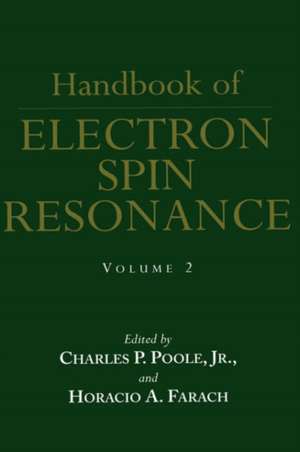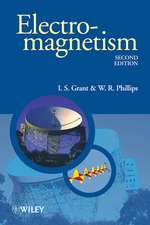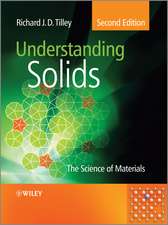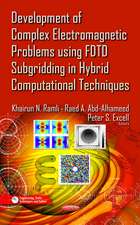Handbook of Electron Spin Resonance: Volume 2
Editat de Charles P. Jr. Poole, Horacio A. Farachen Limba Engleză Hardback – 11 noi 1999
| Toate formatele și edițiile | Preț | Express |
|---|---|---|
| Paperback (1) | 1221.38 lei 6-8 săpt. | |
| Springer – 16 oct 2012 | 1221.38 lei 6-8 săpt. | |
| Hardback (2) | 967.88 lei 6-8 săpt. | |
| American Inst. of Physics – 30 iun 1993 | 967.88 lei 6-8 săpt. | |
| Springer – 11 noi 1999 | 1228.29 lei 6-8 săpt. |
Preț: 1228.29 lei
Preț vechi: 1497.92 lei
-18% Nou
Puncte Express: 1842
Preț estimativ în valută:
235.03€ • 244.91$ • 194.61£
235.03€ • 244.91$ • 194.61£
Carte tipărită la comandă
Livrare economică 03-17 aprilie
Preluare comenzi: 021 569.72.76
Specificații
ISBN-13: 9780387986609
ISBN-10: 038798660X
Pagini: 375
Ilustrații: XI, 375 p.
Dimensiuni: 155 x 235 x 25 mm
Greutate: 0.75 kg
Ediția:1999
Editura: Springer
Colecția Springer
Locul publicării:New York, NY, United States
ISBN-10: 038798660X
Pagini: 375
Ilustrații: XI, 375 p.
Dimensiuni: 155 x 235 x 25 mm
Greutate: 0.75 kg
Ediția:1999
Editura: Springer
Colecția Springer
Locul publicării:New York, NY, United States
Public țintă
ResearchCuprins
I. Sensitivity.- A. Introduction.- B. Minimum Number of Detectable Spins.- C. Predicted Frequency Dependence of ESR Signal, Noise, and Signal-to-Noise Ratio.- D. Performance of Real Systems.- E. Definitions and Derivations.- Acknowledgments.- References.- II. Field-Swept Versus Frequency-Swept Spectra.- A. Introduction.- B. Lineshapes.- C. Applications.- D. Concluding Remarks.- References.- III. Resonators.- A. Introduction.- B. Waveguides and Cavities.- C. Coupling Structures.- D. Velocity and Impedance.- E. Rectangular Resonant Cavity.- F. Cylindrical Resonant Cavity.- G. Special Purpose Cavities.- H. Quality and Filling Factors.- References.- IV. Lineshapes.- A. Introduction.- B. Lorentzian and Gaussian Shapes.- C. Moments and Widths of Resonant Lines.- D. Overlapping Resonances.- E. Convolution Shape.- F. Anisotropicg-Factors.- G. Hyperfine Powder Patterns.- H. Small Spin Clusters.- I. Amorphous and Semirandom Distributions.- J. Conduction Electrons.- K. Exchange.- L. Saturation.- References.- V. Electron Spin Echo Envelope Modulation.- A. Introduction.- B. Qualitative Description of the ESEEM Experiment.- C. Comparison of ESEEM and ENDOR.- D. HYSCORE.- E. Outlook.- References.- VI. Transition Series Ions.- A. Introduction.- B. First-Transition Series (3dnIron Group) Ions.- C. Second-and Third-Transition Series (4dnPalladium and5dnPlatinum Group) Ions.- D. Rare-Earth (4f “) Ions.- E. Actinide(5fn)Ions.- F. S-State (3d54d55d54f7) Ions.- References.- VII. Transition Ion HamiltonianS.- A. Introduction.- B. Site Symmetries.- C. Spin Hamiltonians.- References.- Appendix I. Spin Operators and Their Matrix Elements.- Appendix II. Descent of Symmetry.- Appendix III. Site Symmetries of Host Crystals.- VIII. Transition Ion Data Tabulation.- Tabulations.- References.- IX.Evaluation of Spin-Hamiltonian Parameters from Epr Data of Single Crystals.- A. Introduction.- B. Perturbation Approach.- C. Brute-Force Methods.- D. Least-Squares Fitting (LSF) Method.- E. Other Applications of the LSF Method.- a. Spin Hamiltonian.- b. Eigenvalues.- c. Evaluation of SHP by the LSF Technique.- d. Numerical Evaluation of the Derivatives Required in the LSF Procedure.- e. General Remarks.- F. Discussion.- References.- X. Esr Imaging.- Tabulations.- Acknowledgments.- References.- XI. High Magnetic Fields and High Frequencies.- Tabulations.- Acknowledgments.- References.




















